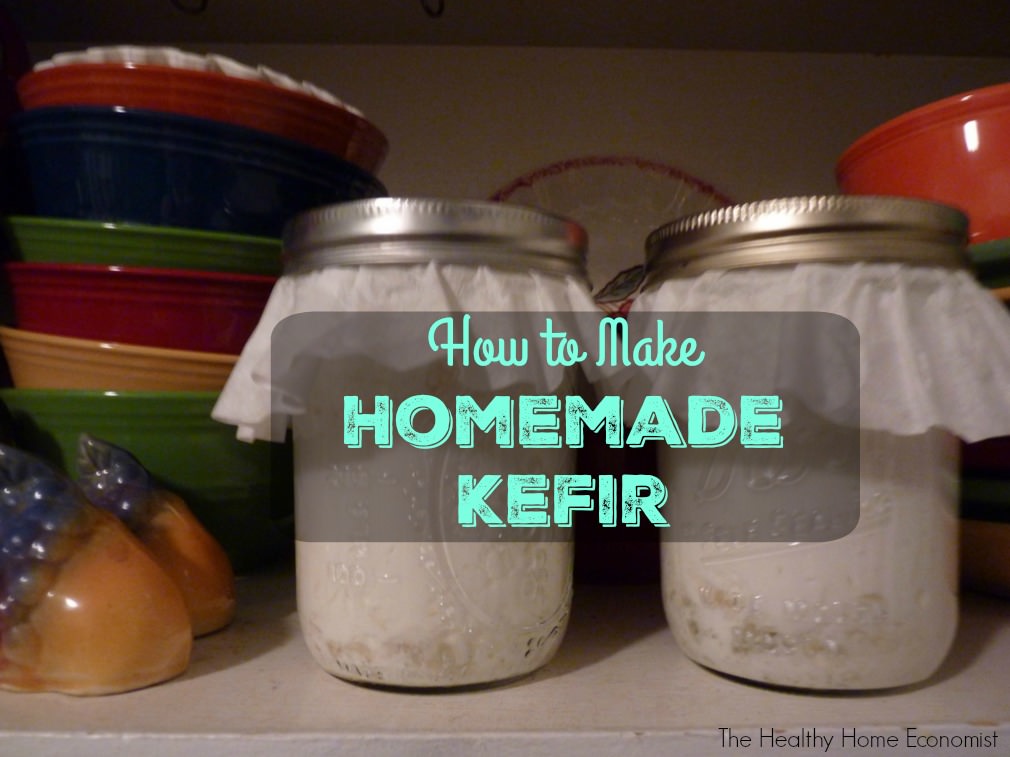Table of Contents[Hide][Show]
How to make homemade kefir the traditional way by fermenting on the counter for 24 hours with farm fresh milk.

I prefer homemade kefir to yogurt because yogurt only has 2-5 strains of beneficial bacteria None of these aggressively attack and destroy pathogens in the gut like the probiotics in kefir do.
By the way, kefir is pronounced ku-feer (not kee-fer or ke-fer).
Kefir made at home has dozens of beneficial bacterial strains as well as several beneficial yeasts. Kefir compared to yogurt is no competition. Kefir is much more beneficial for gut healing.
The one catch is that you need to learn how to make kefir yourself!
Commercial kefir brands typically have far less microbial strains and are not fermented long enough to have the same benefits.
Homemade Kefir Benefits
In a gut that is dominated by pathogens and candida overgrowth (as in someone who has taken many rounds of antibiotics and other prescription drugs over the years and/or eats primarily processed foods), yogurt tends to have only a temporary beneficial impact.
As mentioned earlier, homemade kefir has about 30 beneficial strains of bacteria and yeasts that do aggressively recolonize the gut by destroying pathogens.
As a result, kefir has the potential to permanently alter the gut environment for the better whereas yogurt does not.
The best way to make homemade kefir is to obtain live kefir grains from a friend. They grow slowly over time and extras can be given away (or even eaten as a live probiotic).
Avoid using powdered starter for kefir. It has little to no therapeutic value.
If you cannot find any live grains in your community, you can mail order them.
Other Types of Kefir Made at Home
If learning how to make other types of kefir interests you, check out this video on how to make water kefir.
This video plus recipe on how to make coconut milk kefir is helpful if you wish to make a dairy-free version of the milk-based kefir below.

Homemade Kefir Recipe
Easy recipe for homemade kefir fermented on the counter for 24 hours to maximize beneficial microbial strains for gut healing.
Ingredients
- 1 quart raw milk preferably grass-fed
- 1 wide-mouthed mason jar
- live kefir grains
Instructions
-
Pour the raw milk into a clean glass mason jar leaving about 1 inch at the top. You can use cold milk right out of the refrigerator if this is more convenient. Gently stir in live kefir grains. Roughly one-quarter cup of grains is sufficient to ferment the entire quart.
-
Screw on the lid and leave on the counter at room temperature for 24 hours. Over this time, you will see the milk slightly separate and thicken.
-
The kefir should be ready after 24 hours of fermentation time. If powder culture was used, you can use the kefir as is. If live kefir grains were used, gently strain them out to use again with the next batch of raw kefir.
Recipe Video
Recipe Notes
You do not need to rinse live kefir grains before using again. Rinsing them slightly weakens them in my experience.
Homemade kefir will last many weeks in the refrigerator, but its flavor will get stronger over time.








Will “almost raw” milk work for this recipe? I use Kalona brand which is ultra low pasteurized (slow heated to 145 degrees) and non- homogenized.
Can the kefir be flavored, such as with fruit? If so, what’s the best procedure for doing so? Thank you!
I bought some itty bitty teeny weeny grains from Happy Herbalist. They never got any bigger and simply make curd things. They ferment the milk but I can’t get actual grains to grow. They’re so strong Im using 1tsp in a teaball to culture a quart. HH sells metal strainers and balls specifically for the kefir. It cultures too fast also so I don’t even get a full 24 hrs n it’s almost separating in the jar n chunky. It’s been 2 mos now of use.
Rly just want smooth pleasant smelling kefir ?
I noticed that the kefir grains from Cultures for Health are dehydrated. Are they considered to be “live grains” when dehydrated? Thank you!
Yes, they are still alive.. in a state of suspended animation so to speak (which is possible with microbes). If they were dead, they couldn’t be revived to continue culturing. Here’s how to liven them up to maximum strength. https://www.thehealthyhomeeconomist.com/activate-kefir-grains-fast/